2014 NISSAN JUKE seats
[x] Cancel search: seatsPage 8 of 402
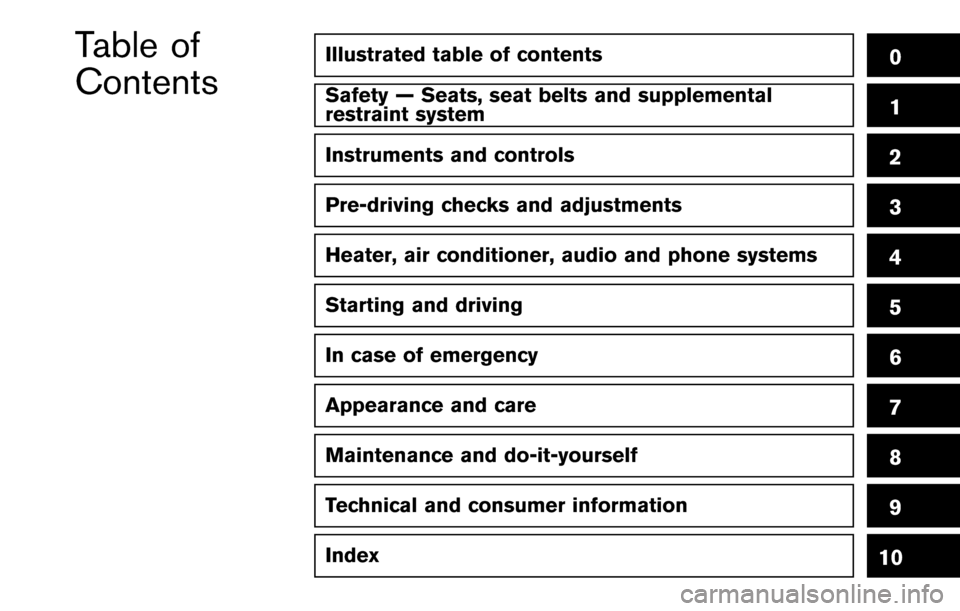
Illustrated table of contents0
Safety — Seats, seat belts and supplemental
restraint system1
Instruments and controls
Pre-driving checks and adjustments
Heater, air conditioner, audio and phone systems
Starting and driving
In case of emergency
Appearance and care
Maintenance and do-it-yourself
Technical and consumer information
Index
2
3
4
5
6
7
8
9
10
Table of
Contents
Page 10 of 402
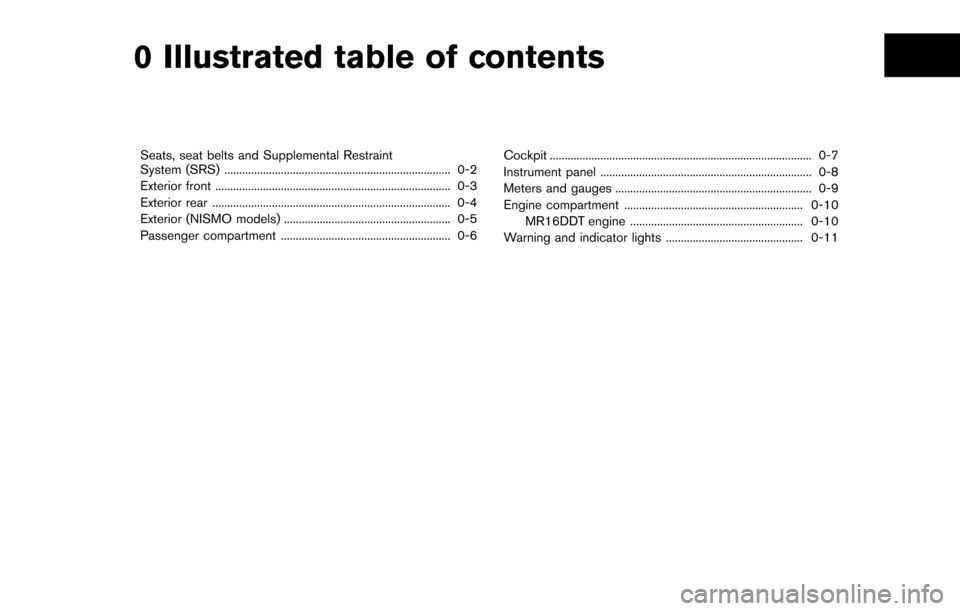
0 Illustrated table of contents
Seats, seat belts and Supplemental Restraint
System (SRS) ........................................................................\
.... 0-2
Exterior front ........................................................................\
....... 0-3
Exterior rear ........................................................................\
........ 0-4
Exterior (NISMO models) ........................................................ 0-5
Passenger compartment ......................................................... 0-6 Cockpit ........................................................................\
................ 0-7
Instrument panel ....................................................................... 0-8
Meters and gauges .................................................................. 0-9
Engine compartment ............................................................ 0-10
MR16DDT engine .......................................................... 0-10
Warning and indicator lights .............................................. 0-11
Page 11 of 402
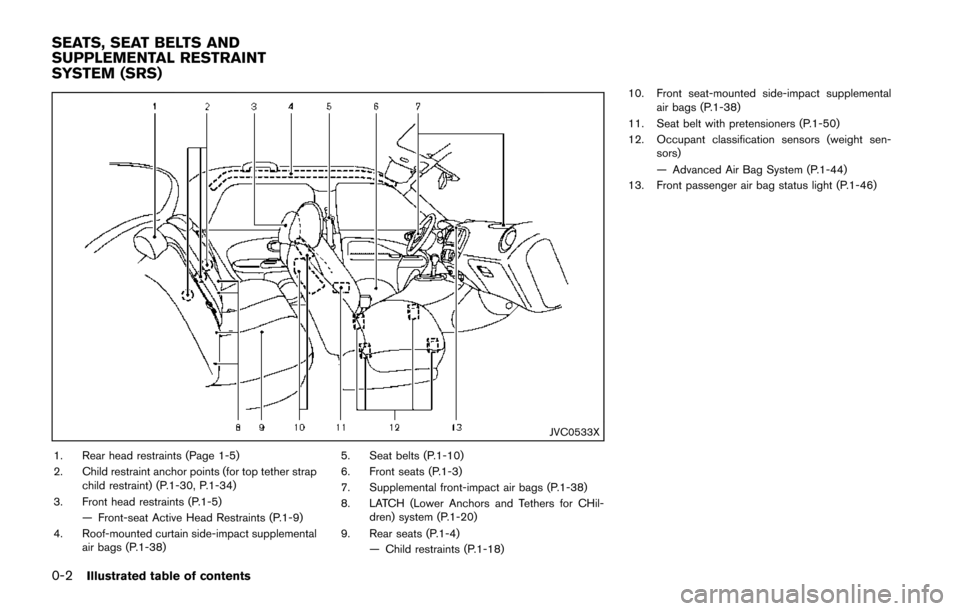
0-2Illustrated table of contents
JVC0533X
1. Rear head restraints (Page 1-5)
2. Child restraint anchor points (for top tether strapchild restraint) (P.1-30, P.1-34)
3. Front head restraints (P.1-5) — Front-seat Active Head Restraints (P.1-9)
4. Roof-mounted curtain side-impact supplemental air bags (P.1-38) 5. Seat belts (P.1-10)
6. Front seats (P.1-3)
7. Supplemental front-impact air bags (P.1-38)
8. LATCH (Lower Anchors and Tethers for CHil-
dren) system (P.1-20)
9. Rear seats (P.1-4) — Child restraints (P.1-18) 10. Front seat-mounted side-impact supplemental
air bags (P.1-38)
11. Seat belt with pretensioners (P.1-50)
12. Occupant classification sensors (weight sen- sors)
— Advanced Air Bag System (P.1-44)
13. Front passenger air bag status light (P.1-46)
SEATS, SEAT BELTS AND
SUPPLEMENTAL RESTRAINT
SYSTEM (SRS)
Page 22 of 402
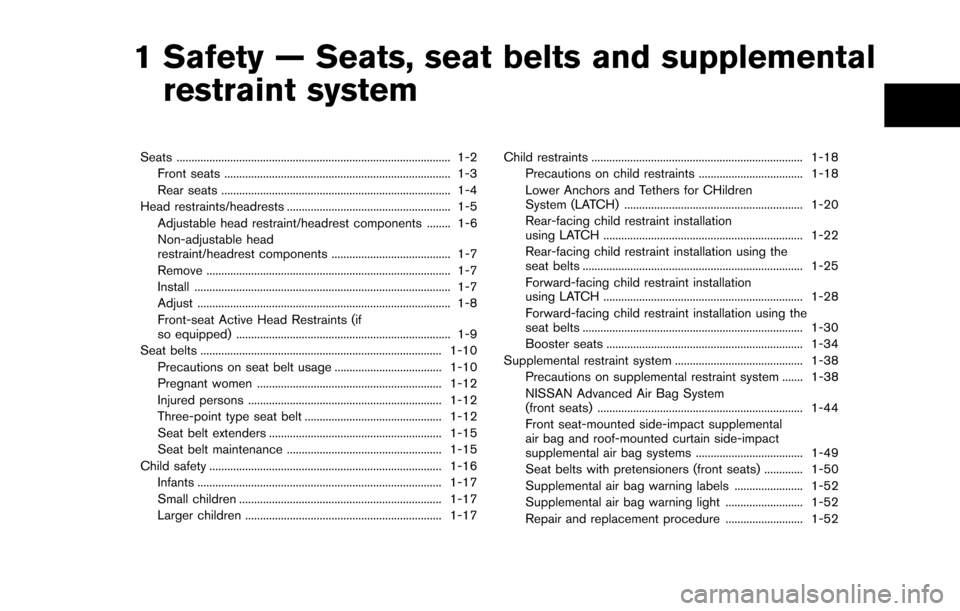
1 Safety — Seats, seat belts and supplementalrestraint system
Seats ........................................................................\
.................... 1-2
Front seats ........................................................................\
.... 1-3
Rear seats ........................................................................\
..... 1-4
Head restraints/headrests ....................................................... 1-5 Adjustable head restraint/headrest components ........ 1-6
Non-adjustable head
restraint/headrest components ........................................ 1-7
Remove ........................................................................\
.......... 1-7
Install ........................................................................\
.............. 1-7
Adjust ........................................................................\
............. 1-8
Front-seat Active Head Restraints (if
so equipped) ........................................................................\
1-9
Seat belts ........................................................................\
......... 1-10
Precautions on seat belt usage .................................... 1-10
Pregnant women .............................................................. 1-12
Injured persons ................................................................. 1-12
Three-point type seat belt .............................................. 1-12
Seat belt extenders .......................................................... 1-15
Seat belt maintenance .................................................... 1-15
Child safety ........................................................................\
...... 1-16 Infants ........................................................................\
.......... 1-17
Small children .................................................................... 1-17
Larger children .................................................................. 1-17 Child restraints ....................................................................... 1-18
Precautions on child restraints ................................... 1-18
Lower Anchors and Tethers for CHildren
System (LATCH) ............................................................ 1-20
Rear-facing child restraint installation
using LATCH ................................................................... 1-22
Rear-facing child restraint installation using the
seat belts ........................................................................\
.. 1-25
Forward-facing child restraint installation
using LATCH ................................................................... 1-28
Forward-facing child restraint installation using the
seat belts ........................................................................\
.. 1-30
Booster seats .................................................................. 1-34
Supplemental restraint system ........................................... 1-38 Precautions on supplemental restraint system ....... 1-38
NISSAN Advanced Air Bag System
(front seats) ..................................................................... 1-44
Front seat-mounted side-impact supplemental
air bag and roof-mounted curtain side-impact
supplemental air bag systems .................................... 1-49
Seat belts with pretensioners (front seats) ............. 1-50
Supplemental air bag warning labels ....................... 1-52
Supplemental air bag warning light .......................... 1-52
Repair and replacement procedure .......................... 1-52
Page 23 of 402
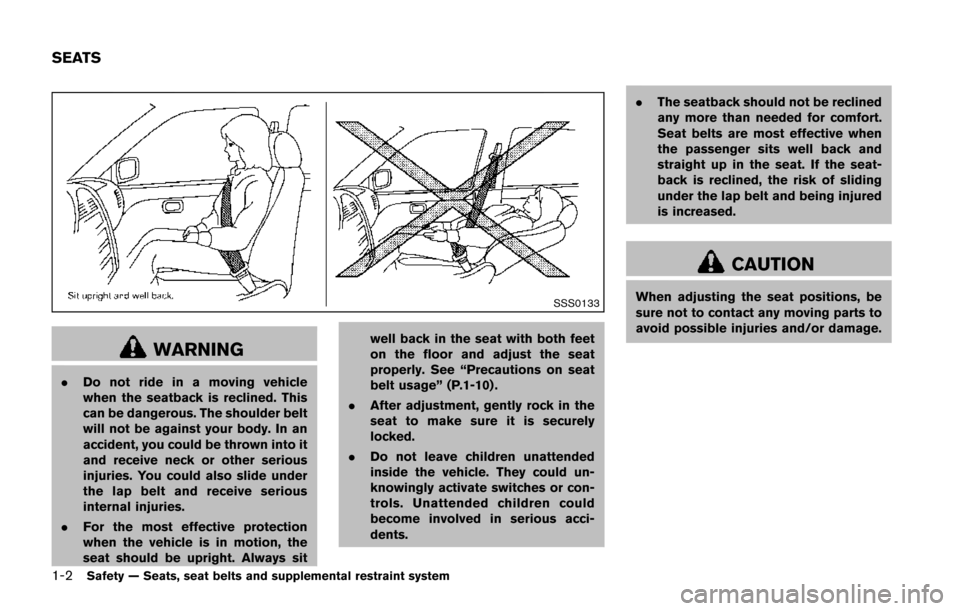
1-2Safety — Seats, seat belts and supplemental restraint system
SSS0133
WARNING
.Do not ride in a moving vehicle
when the seatback is reclined. This
can be dangerous. The shoulder belt
will not be against your body. In an
accident, you could be thrown into it
and receive neck or other serious
injuries. You could also slide under
the lap belt and receive serious
internal injuries.
. For the most effective protection
when the vehicle is in motion, the
seat should be upright. Always sit well back in the seat with both feet
on the floor and adjust the seat
properly. See “Precautions on seat
belt usage” (P.1-10) .
. After adjustment, gently rock in the
seat to make sure it is securely
locked.
. Do not leave children unattended
inside the vehicle. They could un-
knowingly activate switches or con-
trols. Unattended children could
become involved in serious acci-
dents. .
The seatback should not be reclined
any more than needed for comfort.
Seat belts are most effective when
the passenger sits well back and
straight up in the seat. If the seat-
back is reclined, the risk of sliding
under the lap belt and being injured
is increased.
CAUTION
When adjusting the seat positions, be
sure not to contact any moving parts to
avoid possible injuries and/or damage.
SEATS
Page 24 of 402
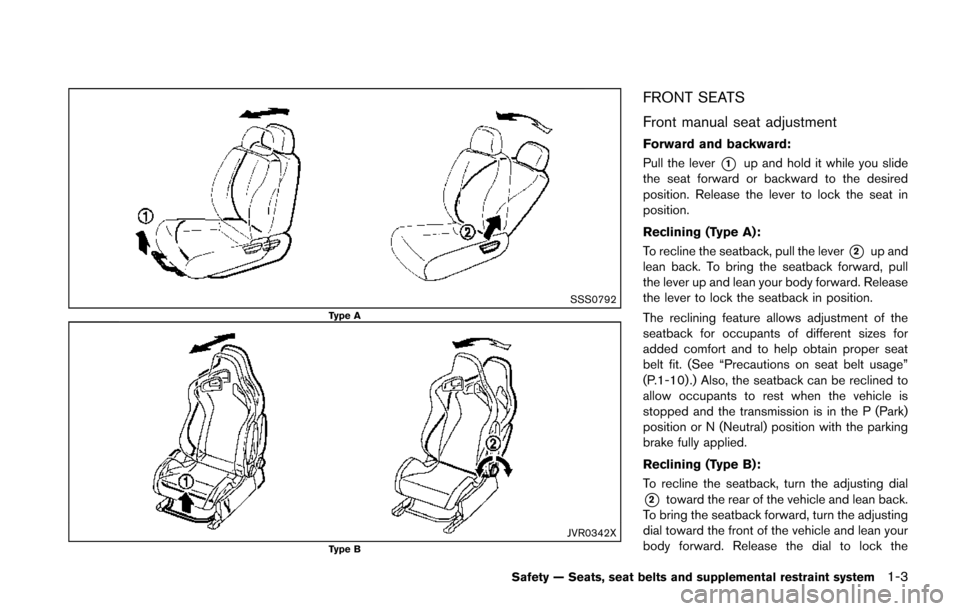
SSS0792Type A
JVR0342XType B
FRONT SEATS
Front manual seat adjustment
Forward and backward:
Pull the lever
*1up and hold it while you slide
the seat forward or backward to the desired
position. Release the lever to lock the seat in
position.
Reclining (Type A):
To recline the seatback, pull the lever
*2up and
lean back. To bring the seatback forward, pull
the lever up and lean your body forward. Release
the lever to lock the seatback in position.
The reclining feature allows adjustment of the
seatback for occupants of different sizes for
added comfort and to help obtain proper seat
belt fit. (See “Precautions on seat belt usage”
(P.1-10) .) Also, the seatback can be reclined to
allow occupants to rest when the vehicle is
stopped and the transmission is in the P (Park)
position or N (Neutral) position with the parking
brake fully applied.
Reclining (Type B):
To recline the seatback, turn the adjusting dial
*2toward the rear of the vehicle and lean back.
To bring the seatback forward, turn the adjusting
dial toward the front of the vehicle and lean your
body forward. Release the dial to lock the
Safety — Seats, seat belts and supplemental restraint system1-3
Page 25 of 402
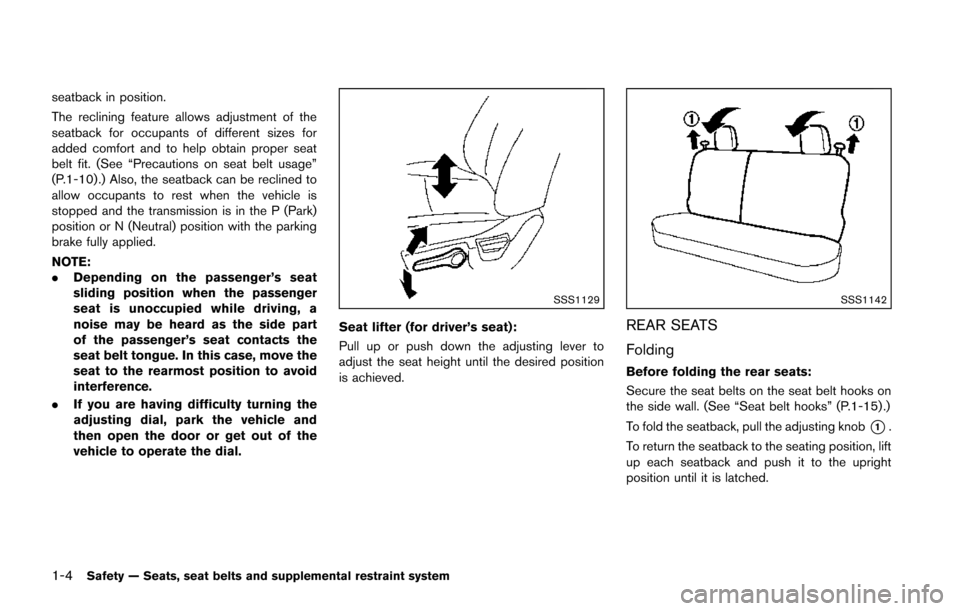
1-4Safety — Seats, seat belts and supplemental restraint system
seatback in position.
The reclining feature allows adjustment of the
seatback for occupants of different sizes for
added comfort and to help obtain proper seat
belt fit. (See “Precautions on seat belt usage”
(P.1-10) .) Also, the seatback can be reclined to
allow occupants to rest when the vehicle is
stopped and the transmission is in the P (Park)
position or N (Neutral) position with the parking
brake fully applied.
NOTE:
.Depending on the passenger’s seat
sliding position when the passenger
seat is unoccupied while driving, a
noise may be heard as the side part
of the passenger’s seat contacts the
seat belt tongue. In this case, move the
seat to the rearmost position to avoid
interference.
. If you are having difficulty turning the
adjusting dial, park the vehicle and
then open the door or get out of the
vehicle to operate the dial.
SSS1129
Seat lifter (for driver’s seat):
Pull up or push down the adjusting lever to
adjust the seat height until the desired position
is achieved.
SSS1142
REAR SEATS
Folding
Before folding the rear seats:
Secure the seat belts on the seat belt hooks on
the side wall. (See “Seat belt hooks” (P.1-15) .)
To fold the seatback, pull the adjusting knob
*1.
To return the seatback to the seating position, lift
up each seatback and push it to the upright
position until it is latched.
Page 26 of 402
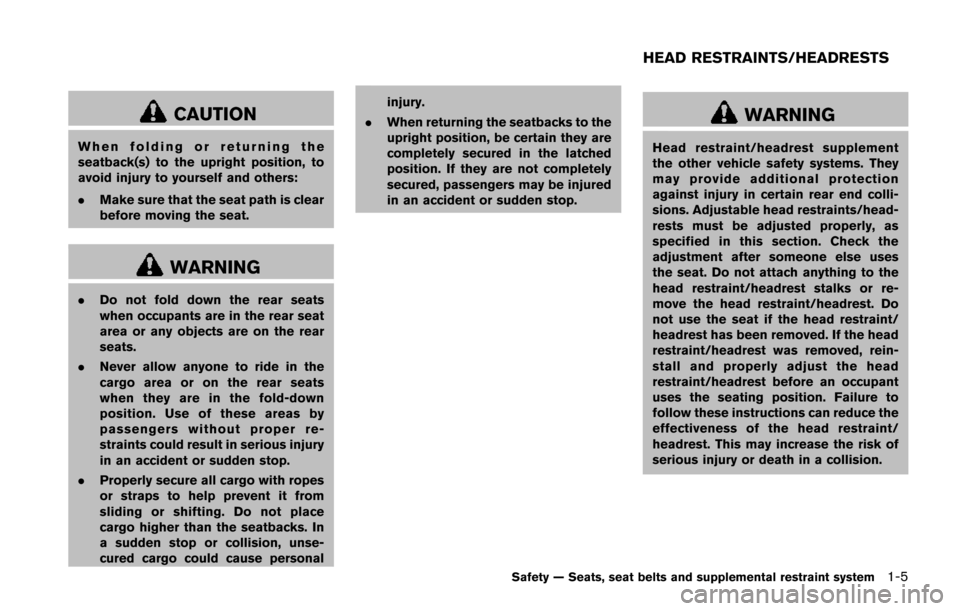
CAUTION
When folding or returning the
seatback(s) to the upright position, to
avoid injury to yourself and others:
.Make sure that the seat path is clear
before moving the seat.
WARNING
.Do not fold down the rear seats
when occupants are in the rear seat
area or any objects are on the rear
seats.
. Never allow anyone to ride in the
cargo area or on the rear seats
when they are in the fold-down
position. Use of these areas by
passengers without proper re-
straints could result in serious injury
in an accident or sudden stop.
. Properly secure all cargo with ropes
or straps to help prevent it from
sliding or shifting. Do not place
cargo higher than the seatbacks. In
a sudden stop or collision, unse-
cured cargo could cause personal injury.
. When returning the seatbacks to the
upright position, be certain they are
completely secured in the latched
position. If they are not completely
secured, passengers may be injured
in an accident or sudden stop.
WARNING
Head restraint/headrest supplement
the other vehicle safety systems. They
may provide additional protection
against injury in certain rear end colli-
sions. Adjustable head restraints/head-
rests must be adjusted properly, as
specified in this section. Check the
adjustment after someone else uses
the seat. Do not attach anything to the
head restraint/headrest stalks or re-
move the head restraint/headrest. Do
not use the seat if the head restraint/
headrest has been removed. If the head
restraint/headrest was removed, rein-
stall and properly adjust the head
restraint/headrest before an occupant
uses the seating position. Failure to
follow these instructions can reduce the
effectiveness of the head restraint/
headrest. This may increase the risk of
serious injury or death in a collision.
Safety — Seats, seat belts and supplemental restraint system1-5
HEAD RESTRAINTS/HEADRESTS